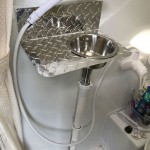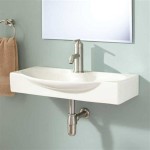How Do I Vent a Bathroom Sink?
A bathroom sink without proper venting can lead to a variety of unpleasant issues, including slow drainage, gurgling noises, and even sewer gas odors. Vent pipes play a crucial role in maintaining a balanced air pressure within the plumbing system, preventing pressure fluctuations and ensuring efficient water flow. This article will guide you through the process of venting a bathroom sink, covering key considerations and steps involved in this essential plumbing task.
Understanding the Importance of Venting
When water flows down the drain of a bathroom sink, it creates a vacuum within the pipes. Without proper venting, this vacuum can impede the flow of water and create other problems. A vent pipe provides an escape route for air, allowing it to enter the plumbing system and equalize the pressure. This prevents the vacuum from forming and ensures unimpeded drainage. Vent pipes also serve to prevent sewer gas from backing up into the sink, ensuring a clean and odor-free bathroom environment.
Determining the Need for Venting
Not all bathroom sinks require individual venting. The need for a dedicated vent depends on factors such as the sink's location and the overall configuration of the plumbing system. Here are some key indicators that suggest a vent may be necessary:
- Slow Drainage: If the sink drains slowly, it could be a sign of insufficient venting.
- Gurgling Noises: A gurgling sound coming from the sink drain indicates air being sucked into the system, suggesting a lack of proper venting.
- Sewer Gas Odors: Foul odors emanating from the sink are a clear indication of a venting issue, as sewer gas is entering the bathroom through the drain.
- Multiple Fixtures on the Same Drain Line: When multiple fixtures, like a bathtub or toilet, are connected to the same drain line, venting becomes crucial to prevent pressure imbalances and ensure proper drainage for all fixtures.
Steps to Vent a Bathroom Sink
Venting a bathroom sink involves installing a vent pipe that connects to the drain line and extends to the roof or above the highest fixture in the plumbing system. Here is a step-by-step guide to properly vent a bathroom sink:
1. Identify the Drain Location
Locate the drain line leading from the bathroom sink. It is typically located under the sink cabinet or within the wall. The drain line should be accessible for the vent installation.
2. Determine the Vent Pipe Size
The size of the vent pipe should correspond to the size of the drain line. Consult plumbing codes in your area to determine the appropriate vent pipe diameter. In most cases, a 1.5-inch vent pipe will suffice for a standard bathroom sink.
3. Choose a Vent Pipe Material
Vent pipes can be made from various materials, including PVC, ABS, or copper. PVC and ABS are commonly used for drainage and venting due to their affordability and durability. Copper vent pipes are more expensive but offer greater longevity and resistance to corrosion.
4. Install the Vent Pipe
Start by connecting the vent pipe to the drain line using a vent tee fitting. The vent tee should be installed at a point where the drain line is accessible. Cut the vent pipe to the required length, ensuring it extends above the highest fixture in the plumbing system. If venting to the roof, ensure the vent pipe is properly sealed and weatherproofed.
5. Connect to the Roof or Vent Stack
If venting to the roof, connect the vent pipe to the roof vent stack using a vent cap. The vent cap should be designed to prevent water from entering the vent pipe. If venting to a vent stack, connect the vent pipe to the stack using a vent tee or a vent cap.
6. Secure the Vent Pipe
Use pipe straps or clamps to secure the vent pipe to the wall or framing. Ensure that the pipe is properly supported and does not sag. Secure the pipe at intervals of approximately 4 feet to maintain its stability and prevent movement.
7. Inspect and Test
After installation, thoroughly inspect the vent pipe for any leaks or loose connections. Once satisfied, run water from the bathroom sink and check for any signs of improper drainage, gurgling noises, or sewer gas odors. If any issues arise, re-inspect the vent pipe and connections to ensure they are correctly installed.
Vent pipes play a crucial role in maintaining a healthy and efficient plumbing system. By understanding the importance of venting and following the steps outlined in this guide, you can ensure that your bathroom sink operates smoothly and efficiently. Remember to consult with a qualified plumber if you are unsure about any aspect of the venting process.
Can You Drain A Sink Into Toilet Vent Quora

How To Vent A Toilet Sink And Shower Drain
Can You Vent A Toilet Line Through Sink Drain Quora

Vent Options For Plumbing Drains Fine Homebuilding

Vent Options For Plumbing Drains Fine Homebuilding

How To Plumb A Bathroom With Multiple Plumbing Diagrams Hammerpedia

Plumbing Vents The Ultimate Guide Hammerpedia

How Does Your Bathroom Sink Drain And Vent Pipes Work

Magic Vent

Pin On House
Related Posts







